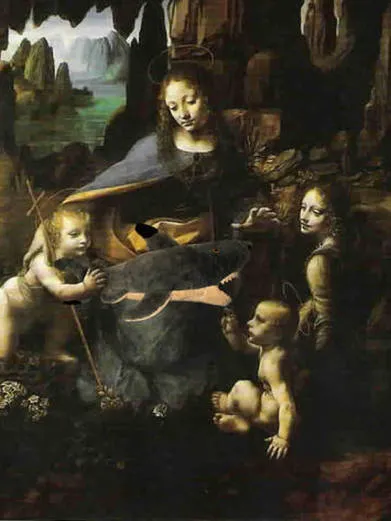
Leonardo da Vinci es, sin duda, una de las figuras más fascinantes que han existido en la historia. El genio florentino dejó para la posteridad cuadros que aún siguen llamando la atención de los hombres modernos, además de pintor fue anatomista (sus extraordinarios dibujos avalan su vena más médica), paleontólogo, botánico, escultor e incluso inventor (realizó esbozos de lo que serían predecesores del helicóptero, el reloj o el mortero).
Los misterios que envuelven sus cuadros aún no se han desentrañado del todo. 'La última cena', por ejemplo, está plagado de pequeños mensajes que el pintor quiso dejar sin resolver para aquellos con suficiente ojo como para encontrarlos. 'La Gioconda', por su parte, sigue suscitando un enorme interés por su extraña sonrisa. Durante mucho tiempo se dudó de la identidad de la modelo, y diversas hipótesis sobre ella y su supuesto embarazo llaman aún la atención de los especialistas.
Secretos y misterios
Pero es otro cuadro el que recientemente ha sorprendido, 'La Virgen de las rocas'. Como sucede con otras obras de Da Vinci, como la mencionada 'Mona Lisa', existen varias versiones con el mismo nombre y la misma temática de este cuadro, además de distintos bocetos. Las dos más famosas se encuentran en el Museo del Louvre y en la National Gallery de Londres. La pintura muestra a la Virgen junto al niño, Juan Bautista y un ángel. Una obra con un significado fuertemente religioso y de alabanza a María, que, sin embargo, no está exento de polémica. Gracias a una técnica llamada macro fluorescencia de rayos X se ha descubierto en la pintura el boceto de un niño Jesús con alas, borrado en el pasado Hace unos años, un equipo de expertos italianos en arte lograron descomponer la obra para analizarla hasta el más mínimo detalle. Descubrieron así que se puede apreciar un perro con una correa entre las hojas y las rocas de la parte superior del cuadro, lo que, presuntamente, representaría para Leonardo la desobediencia y la acusación de corrupción del papado de la época.
Leonardo da Vinci is undoubtedly one of the most fascinating figures that have ever existed in history. The Florentine genius left for posterity paintings that still attract the attention of modern men, in addition to being a painter he was an anatomist (his extraordinary drawings support his most medical vein), paleontologist, botanist, sculptor and even inventor (he made sketches of what would be helicopter, watch or mortar predecessors).
The mysteries surrounding his paintings have yet to be fully unraveled. 'The Last Supper', for example, is full of small messages that the painter wanted to leave unresolved for those with enough eye to find them. 'La Gioconda', for its part, continues to arouse enormous interest for its strange smile. For a long time the identity of the model was doubted, and various hypotheses about her and her supposed pregnancy still attract the attention of specialists.
Secrets and mysteries
But it is another painting that has recently surprised, 'The Virgin of the rocks'. As with other works by Da Vinci, such as the aforementioned 'Mona Lisa', there are several versions with the same name and the same theme of this painting, as well as different sketches. The two most famous are in the Louvre Museum and the National Gallery in London. The painting shows the Virgin with the child, John the Baptist and an angel. A work with a strongly religious meaning and in praise of Mary, which, however, is not without controversy. Thanks to a technique called macro X-ray fluorescence, the sketch of a baby Jesus with wings has been discovered in the painting, erased in the past A few years ago, a team of Italian art experts managed to decompose the work to analyze it to the smallest detail detail. They thus discovered that a dog can be seen on a leash between the leaves and rocks in the upper part of the painting, which, presumably, would represent for Leonardo the disobedience and accusation of corruption of the papacy of the time.
"Fue como buscar una aguja en un pajar, la sensación de descubrir las alas y la cabeza fue indescriptible" explicó en un comunicado Pier Luigi Dragotti, profesor del Departamento de Ingeniería Electrónica y Electrónica del Imperial College de Londres. La técnica funciona utilizando elementos químicos individuales en la pintura, lo que hace que brillen levemente en formas que un escáner sensible puede captar. Se ha utilizado durante más de una década, y el Jesús recién descubierto fue encontrado gracias a un nuevo algoritmo para interpretar los datos. Lo ha desarrollado Dragotti.
"It was like looking for a needle in a haystack, the sensation of discovering the wings and the head was indescribable," Pier Luigi Dragotti, professor in the Department of Electronic and Electronic Engineering at Imperial College London, explained in a statement. The technique works by using individual chemicals in the paint, causing them to glow faintly in ways that a sensitive scanner can pick up. It's been used for more than a decade, and the newly discovered Jesus was found thanks to a new algorithm to interpret the data. It was developed by Dragotti.
